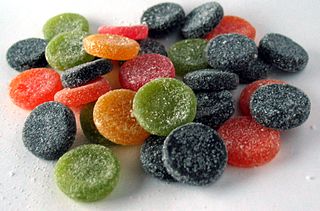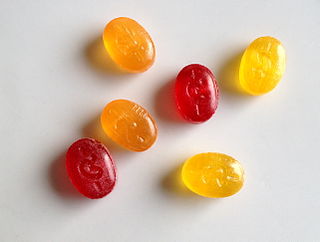
Turku is a city in Finland and the regional capital of Southwest Finland. It is located on the southwestern coast of the country at the mouth of the River Aura. The population of Turku is approximately 206,000, while the metropolitan area has a population of approximately 315,000. It is the 6th most populous municipality in Finland, and the third most populous urban area in the country after Helsinki and Tampere.

Altoids are a brand of mints, sold primarily in distinctive metal tins. The brand was created by the London-based Smith & Company in the 1780s, and became part of the Callard & Bowser company in the 19th century. Their advertising slogan is "The Original Celebrated Curiously Strong Mints", referring to the high concentration of peppermint oil used in the original flavour lozenge. The mints were originally conceived as a lozenge intended to relieve intestinal discomfort.

Finnish cuisine is notable for generally combining traditional country fare and haute cuisine with contemporary continental-style cooking. Fish and meat play a prominent role in traditional Finnish dishes in some parts of the country, while the dishes elsewhere have traditionally included various vegetables and mushrooms. Evacuees from Karelia contributed to foods in other parts of Finland in the aftermath of the Continuation War.

The Heath bar is a candy bar made of toffee, almonds, and milk chocolate, first manufactured by the Heath Brothers Confectionery in 1928. The Heath bar has been manufactured and distributed by Hershey since its acquisition of the Leaf International North American confectionery operations late in 1996.

GB Glace is the largest ice cream company in Sweden. It was founded in 1942 and after they had become a partner in 1973, was eventually fully purchased by the British company Unilever in 1996.

Pantteri, sold in Sweden as Katten, is a brand of Finnish salmiakki candy, made by Fazer.

Swedish Fish is a fish-shaped, chewy candy said to have been originally developed by Swedish candy producer Malaco in 1957 for the U.S. market. They come in a variety of colors and flavors.

Ricola Ltd./RicolaAG is a Swiss manufacturer of cough drops, instant tea, tea bags, and breath mints. The head office of Ricola is located in Laufen, Basel-Country and has subsidiaries in Italy, Great Britain, Asia, and the United States. According to the company, it exports to around 45 countries in Europe, Asia, and North America.
Lotte Wellfood Co., Ltd., formerly Lotte Confectionery, is a South Korean international confectionery company headquartered in Seoul, South Korea. The company was established in 1967. Currently, it is the third-largest chewing gum manufacturer in the world, and its plants are located in Kazakhstan, Pakistan, Belgium, India, Russia, Myanmar, and China. Lotte Confectionery was renamed Lotte Wellfood in 2023, after being merged with Lotte Foods in 2022.

Leaf International BV was a confectionery company founded in the 1940s. Leaf had sales of approximately €527m (2010) and 2,400 employees. It had 11 factories in seven countries. Leaf was owned by CVC Capital Partners, Nordic Capital, and management. Bengt Baron was the CEO of Leaf.

Farley's & Sathers Candy Company was created as an umbrella company to roll up many small companies, brands and products under a common management team. The confectionery business segment is made up of many small companies, often with intertwined relationships and histories.
Chewits is the brand name of a cuboid-shaped, soft chewy candy manufactured by Cloetta.

A hockey card is a type of trading card typically printed on some sort of card stock, featuring one or more ice hockey players or other hockey-related theme and are typically found in countries such as Canada, the United States, Finland and Sweden where hockey is a popular sport and there are professional leagues. The obverse normally features an image of the subject with identifying information such as name and team. The reverse can feature statistics, biographical information, or as many early cards did, advertising. There is no fixed size or shape of hockey cards, running the gamut from rectangular to circular, however modern North American cards have typically standardized on a 2.5-by-3.5-inch rectangular format.
Two multi-national companies, Wrigley and Cadbury, together account for some 60% market share of the worldwide chewing gum market. The global market shares for the top five chewing gum companies are estimated to be:

Nesquik is a brand of food products made by Swiss company Nestlé. In 1948, Nestlé launched a drink mix for chocolate-flavored milk called Nestlé Quik in the United States; this was released in Europe during the 1950s as Nesquik.

Katjes International GmbH & Co. KG, headquartered in Emmerich am Rhein, is part of the Katjes Group, along with its sister company Katjes Fassin GmbH + Co. KG and Katjesgreenfood GmbH & Co. KG. The company is focused on investments in the Western European sugar confectionery market.

Mynthon is a Finnish brand of pastilles owned by Cloetta. It has been produced since the 1970s. Mynthon is the best selling brand of pastilles in Finland with a market share of about 30%: its annual sales are about 22 million items. As well as Finland, Mynthon is sold in the Baltic countries, Sweden and Norway. Mynthon is considered an icon of refreshment. The pastilles are especially used to relieve a sore throat.

Oy Merijal Ab was a Finnish candy factory based in Oulu.

Aakkoset is a Finnish brand of candy sold in Finland since 1970, currently sold by Cloetta under the Malaco brand name. The name "Aakkoset" comes from the various capital letters of the alphabet decorating the lozenge-shaped candies.
Pingviini is a Finnish brand of ice cream owned by Fronen Finland. Known for its logo featuring a penguin, Pingviini brand ice cream has been sold in Finland since the 1930s.
















